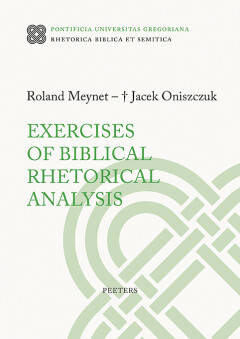
- Afhalen na 1 uur in een winkel met voorraad
- Gratis thuislevering in België vanaf € 30
- Ruim aanbod met 7 miljoen producten
- Afhalen na 1 uur in een winkel met voorraad
- Gratis thuislevering in België vanaf € 30
- Ruim aanbod met 7 miljoen producten
Zoeken
Exercises of Biblical Rhetorical Analysis
Translation of the Second French Edition
R Meynet, J Oniszczuk
€ 254,45
+ 508 punten
Omschrijving
These exercises are based on R. Meynet's Treatise on Biblical Rhetoric. The Treatise is a kind of grammar, and everyone knows that you cannot learn a language by reading or even memorising its rules of grammar: one must learn by practising them patiently, and this requires much exercise. Many people are interested in biblical rhetorical analysis for its results in better understanding biblical texts; however, some are not content with that and would like to use the methodology themselves. Like any profession, a serious apprenticeship is necessary. The ideal would be to train under the guidance of a competent master who can follow the students' work, advise them and correct them when necessary. This book is intended as a guide, like a master. They begin with a series of exercises, organised on two levels: that of the passage (or 'pericope'), then that of the 'sequence' or structured group of passages. The text to be analysed is given in the original language alongside a very literal translation; some advice follows, especially to read and study a given part of the Treatise which will be essential for the exercise in question; finally, a whole series of questions is provided to enable the learners, if they so wish, to find out for themselves how the text is composed. The second part contains the "answer" to the exercises. The path suggested by the questions in the exercises is followed step by step. These answers enable learners to check their own work. This book of Exercises is not a book to be read, but a book to be written. To be satisfied-as one might be tempted to do-with reading the answer, before having done the exercise, would serve little purpose for those who do not wish to simply accumulate knowledge, but to learn how to work which is not-at all-the same thing. This second edition has not only corrected the errors, but also replaced some of the exercises with new ones that are more appropriate. In addition, the colours should help to enhance learning.
Specificaties
Betrokkenen
- Auteur(s):
- Uitgeverij:
Inhoud
- Aantal bladzijden:
- 365
- Taal:
- Engels
- Reeks:
- Reeksnummer:
- nr. 53
Eigenschappen
- Productcode (EAN):
- 9789042954861
- Verschijningsdatum:
- 20/08/2025
- Uitvoering:
- Paperback
- Formaat:
- Trade paperback (VS)
- Afmetingen:
- 170 mm x 240 mm
- Gewicht:
- 426 g

Alleen bij Standaard Boekhandel
+ 508 punten op je klantenkaart van Standaard Boekhandel
Beoordelingen
We publiceren alleen reviews die voldoen aan de voorwaarden voor reviews. Bekijk onze voorwaarden voor reviews.








